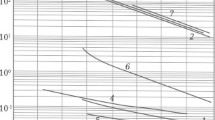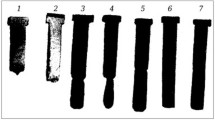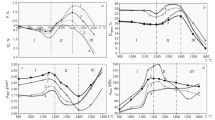The use of refractory articles in an electric glassmaking furnace is analyzed. It is noted that on the basis of experience in operating electric furnaces chromium-corundum ceramic refractories hold promise for use in such furnaces.
Similar content being viewed by others
Avoid common mistakes on your manuscript.
The technology for making C glass and the production of chopped fibers for glass-fiber mat with density 35 – 110 g/m2 were adopted at Mostermosteklo, JSC (Zheleznodorozhnyi) in 1993 – 1995. The Lipeks Company (Germany) supplied the electrical equipment, control equipment, and raw materials preparation and transportation technology in a turnkey arrangement. This firm also installed and supervised the installation of the equipment for reprocessing glass-fiber wastes and glass-fiber mat conveyer. Fiber with diameter 11 – 13 μm was produced using a 6 m2 electric glassmaking furnace, designed by the Japanese company Teko-Toledo, with plate electrodes, six electrodes for each longitudinal side of the furnace (Fig. 1). The power consumption was 340 – 350 kW/h and the furnace capacity was 8 – 8.5 tons/day.
The composition of the glass (content, %Footnote 1) was as follows: 66 SiO2, 5.5 Al2O3, 4.8 B2O3, 7.3 CaO, 2.2 MgO, 13.5(Na2O + K2O). The density was 2.5 g/cm3 and the softening temperature 750°C. A simplified scheme of the melter is displayed in Fig. 2. During the first run of the furnace all walls of the melter (longitudinal 1 and transverse 2) were made from high-density grade K-3 electro-fused castable refractory with 29% content of Cr2O3 (Monofraks Company). When using such a refractory the furnace at startup must be heated gradually without any thermal shocks, especially at the moment when water is fed into the electrode holders.
The electrode holders are an important element of the furnace heating system. Electrode holders with the same design were used in the first and subsequent furnace runs (Fig. 3). This is an open-type electrode holder (there is no inner tube in it), and cooling is done by water fed directly to a molybdenum adapter. A drawback of this design is that water can reach a refractory if the recesses of the electrode rod are not adequately ‘sealed’ by the molten glass, as a result of which the refractory in the zone of the electrode holder can crack and expand. As a result of wear of the electrode holders, after 3 – 3.5 yr of operation cracks are observed in electro-fused castable refractories right up to local failure of the beam of the refractory on the interior side of the melter, which reduces the furnace run time. When the electrode holders fail (at the end of a run) the molten glass approaches close to the exterior surface of the furnace walls, which requires that they be additionally cooled by air.
Practice has shown that the design of the electrode holders must be improved. The run of an electric furnace whose brickwork was comprise of electro-fused castable refractory with 29% Cr2O3 was four years and showed good results, in spite of the short period of assimilation of the technology. However, the high density and low heat resistance of this refractory complicates its use in the masonry of electric furnaces.
For the next furnace run the VRD-Glas company sent to Mostermosteklo a proposal for integral delivery of refractory materials (furnace and feeder). The walls of the furnace melter were to be made of SUPRAL RK-70 ceramic chromium-corundum blocks (70% Cr2O3) with improved resistance to corrosion. This refractory with ceramic binder is more heat-resistant. It was recommended that the furnace bottom be made of SUPRAL RK-30S chromium-corundum ceramic refractories (30% Cr2O3). This refractory possesses the requisite corrosion resistance for this zone of the furnace and in this connection is preferable to the K-3 electro-fused castable refractory (Monofraks Company).
The physical and technical properties and chemical composition of the chromium-corundum ceramic refractories from the Didier Company (Germany) are presented in Tables 1 and 2.
The VRD-Glas Company informed the specialists at Mostermosteklo and the Scientific-Industrial Association Stekloplastik that it has delivered to one of the customers a complete set of refractories (manufactured by the Didier Company, Germany) for a furnace producing glass fibers and that the experience gained in operating this furnace showed that because of their high quality the chromium-corundum ceramic refractories work well in contact with the glass. VRD-Glas proposed the following variant for laying the refractory: the refractory Supral RK-70 will be used for all walls (longitudinal and transverse) of the furnace melter (see Fig. 2).
On the basis of the existing experience the specialists at the Scientific-Industrial Association Stekloplastik and Mostermosteklo have voiced doubt in the validity of using the SUPRAL RK-70 chromium-corundum ceramic refractory simultaneously in the longitudinal and end walls of the melter of the electric furnace with the electrodes arranged in the longitudinal walls of the melter. It is known that all existing melters with refractories containing > 30% Cr2O3 are heated by bottom electrodes or electrodes installed through the furnace roof but not the electrodes placed in the longitudinal walls of the melter.
VRD-Glas has a great deal of experience in using chromium-corundum ceramic refractories in glassmaking furnaces, e.g., Pfeiderer (Hungary, Slovenia, Germany), Izotoprak (Turkey), Glaswolle Wiesbaden (Germany), Sager AG Glaswolle (Switzerland), Gullfiber (Sweden), and Isover (France). However, these glassmaking furnaces are mainly gas-heated and the Gold Top furnaces are heated by roof electrodes. The electric conductivity of the refractories should also be noted: SUPRAL RK70 (1400°C) = 350 Ω/cm and SUPRAL RK30S (1400°C) = 1700 Ω/cm. In addition, the electric conductivity of C glass at 1400°C is 100 Ω/cm.
On this basis the specialists at the Scientific-Industrial Association Stekloplastik and Mostermosteklo have proposed using the refractory layout shown in Fig. 4. This combination of refractories solves the problem of the electric conductivity of the furnace, which will give uniform wear of the refractories of the entire furnace melter. The use of SUPRAL RK-30S refractory (with quite high resistance) in the end walls of the furnace will make it possible to eliminate from the electric furnace control-free sections between the electrodes, which can lead to short-circuiting on the side walls of the furnace.
So, the investigations performed by American specialists with 94 – 96% chromium oxide on melting E glass [1] showed that the service life of chromium oxide refractory decreases by 90% at current 2 A/in2 and 98% at 8.8 A/in2.
The furnace run with the altered arrangement of the melter walls (see Fig. 4) showed a quite extended furnace life to four years and seven months. The run time of the furnace was limited by failed electrodes, which were impossible to replace while the furnace was in operation. The electrodes begin to malfunction between 3.5 and 4 yr of service. The last run was longer because chromium-corundum ceramic refractories were used. In addition, the chromium-corundum ceramic refractory used is more heat resistant than electro-fused castable refractories. The fulfillment of all technical requirements for the installation of plate electrodes, electrode holders, and progressive uniform heating of the furnace made it possible avoid ‘traumatizing’ the refractory blocks. Ultimately, the electric furnace emerged in the working regime without a single crack. The amount of product produced in four years is much greater than the amount produced for the same period of time in the first run of the electric furnace. This run of the electric furnace was the most stable and longest. The heating system of the electric furnace failed in practice by 80% in four years and could not support glassmaking. The state of the refractory remained satisfactory, and so as not to stop the electric furnace additional rod molybdenum electrodes had to be installed (three on the left-hand side and two on the right-hand side). An electrode was installed in the top structure of the side wall of the furnace (Fig. 5).
The installed electrodes assumed electric loads and gave the required melting regime. The technical measure of installing additional electrodes at the top is a first; it was accomplished competently and has no analogs in domestic practice. Since the subsequent wear time of the electrodes was difficult to predict, after seven months the question of whether or not the furnace should be stopped was raised. The electric furnace operated for 4 yr and 7 months, exceeding by 7 months the operating time of all previous runs.
Examination of the technical condition of the electric furnace producing fiber-glass mat at the end of a run revealed the following:
-
1.
the electrode recesses are not damaged (in previous runs they reduced the service life of the furnace as a result of small water flows through the electrode holders);
-
2.
the furnace wall adjoining the furnace throat and the throat itself raise some misgivings because of reddening of the seams and very small outflow of molten glass through the seams into the external insulation;
-
3.
the top structure of the furnace (roof) is in good condition;
-
4.
the overlapping of the forechannel and joint of the forechannel are in satisfactory condition; the burner blocks of the forechannel show damage on the interior side at the locations of the burner nozzles; reddening of the exterior surface is observed in the bottom structure of the forechannel, i.e., the inner glass-side blocks are significantly corroded (chromium-corundum refractory);
-
5.
the overlapping of the feeder showed no burnouts and was in satisfactory condition; the feeder chimney was strongly corroded; similar damage was found on the burner tuyeres of the feeder due to an increase in the temperature at the locations of the burner nozzles;
-
6.
several of the slotted bottom bricks were strongly damaged (the slotted bottom bricks remained unchanged for the entire run of the electric furnace).
In summary, the following conclusions can be drawn concerning the condition of the furnace, forechannel, and feeder after operation for 4 yr and 7 months.
-
1.
The condition of the furnace, forechannel, and feeder at the moment operation stopped cannot be regarded as critical.
-
2.
Up to the moment operation stopped the electric furnace operated in the prescribed process regime and allowed full production.
-
3.
The experience gained in operating the furnace shows that the foreign-made chromium-corundum ceramic refractories (30 – 70% Cr2O3) have good corrosion resistance for C glass and showed that these refractories can be used not only in gas furnaces but also in electric furnaces. The Scientific-Industrial Association Stekloplastik also has experience in using the Russian made (NTTS Bakor JSC) chromium-corundum refractory with ceramic binder KhKT (60% Cr2O3). This refractory was used in the flow unit of an electric furnace with a different design for making high-alkali glass (20% Na2O). After two years of operation the refractory showed itself to be much more resistant to corrosion than BK-37 electro-fused castable baddeleyite-corundum refractory.
-
4.
Molybdenum electrodes and electrode holders limit the run time of an electric furnace.
-
5.
The use of the chromium-corundum ceramic refractories SUPRAL RK-70 and SUPRAL RK-30S with the presented variant of the arrangement of the melter walls of the electric furnace for making C glass significantly extended the furnace run time.
-
6.
However, there is a negative side to the use of chromium-corundum ceramic refractories: the color of the glass (for long feeders and in the presence of a forechannel), which is visible in the fabrication of massive articles. In addition, the content of chromium in the glass is thousandths of a percent. For electric furnaces with a short through channel the green color appears only during the first month of operation, after which it almost vanishes.
Notes
Here and below, the content by weight, %.
References
John W. Overman, David H. Wilson, and Charles F. Schroeder, Apparatus and Method for Increasing Furnace Life in an Electric Furnace for Thermoplastic Materials, Patent USA No. US39670464A; Corning Fiberglas Corporation, Toledo (1976); URL: https://docviewer.yandex.ru/?url=ya-mail%3A%2F%2F2530000002364491540%2F1.2&name=US3967046.pdf&c=546054dc9afa.
Author information
Authors and Affiliations
Corresponding author
Additional information
Translated from Steklo i Keramika, No. 12, pp. 38 – 41, December, 2014.
Rights and permissions
About this article
Cite this article
Krasil’shchikov, B.N., Saifutdinov, S.K., Shustrov, N.N. et al. Experience in Using Chromium-Corundum Ceramic Refractories in an Electric Glassmaking Furnace for Making C Glass. Glass Ceram 71, 452–455 (2015). https://doi.org/10.1007/s10717-015-9709-3
Published:
Issue Date:
DOI: https://doi.org/10.1007/s10717-015-9709-3









